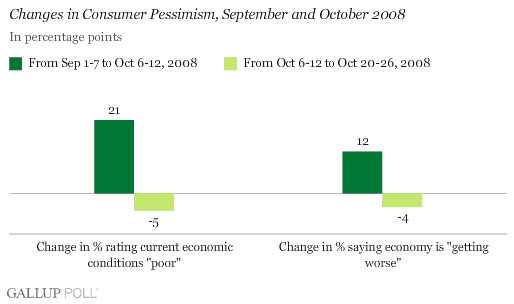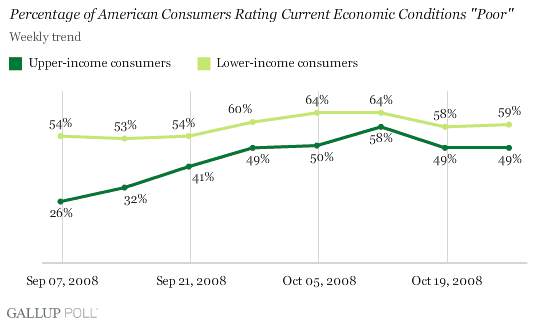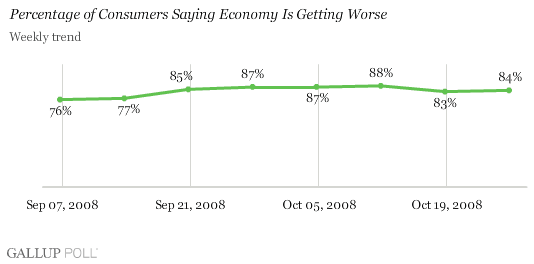PRINCETON, NJ -- The recently reported consumer confidence/sentiment measures reflect Gallup's mid-October percentages rating the economy "poor" (up 21 points) and saying the economy was getting worse (up 12 points) that were substantially above the early September readings. However, since mid-October, Gallup Poll Daily tracking shows consumer pessimism easing slightly -- the percentage rating the economy "poor" is down 5 points and the percentage saying it is "getting worse" is down 4 points.

Percentage Rating Economy "Poor" Moderates
During the week of Sept. 1-7, 39% of consumers rated current economic conditions "poor." By the week of Oct. 6-12 -- after the financial chaos surrounding the Treasury bailout and during one of the worst weeks for the stock market in history -- the percentage rating the economy "poor" had increased to 60%. However, since that time, pessimism has eased a little, with the percentage rating the economy "poor" declining to 55% in each of the past two weeks.

Not surprisingly, the financial crisis has had its most pronounced effect on upper-income Americans. The percentage of this group rating the economy as poor increased from 26% during the first week of September to 58% during the second week of October. However, since then, pessimism among upper-income households has eased somewhat; "poor" ratings declined to 49% during the week of Oct. 20-26. The economic attitudes of lower-income consumers -- which were already quite negative in early September, with 54% rating the economy "poor" -- reached 64% during the first two weeks of October before also falling back to 59% during the week of Oct. 20-26.

Percentage Saying Economy "Getting Worse" Moderates
During the first week of September, 76% of consumers said the economy was getting worse. Five weeks later, in mid-October, that percentage had increased to 88%. However, in another sign that consumer pessimism has eased a little, the percentage saying the economy is getting worse has declined to 83% and 84%, respectively, in each of the past two weeks.

The percentage of upper-income Americans saying the economy is getting worse increased from 70% during the first week of September to 92% during the second week of October. However, since then, the percentage of upper-income households holding this view has eased somewhat to 84% during the week of Oct. 20-26. The percentage of lower-income consumers saying the economy is getting worse -- which stood at 87% in early September -- reached 89% during the first week of October before also falling back to 85% during the week of Oct. 20-26.

Commentary
Gallup's weekly view of consumer confidence reveals two important trends masked by the monthly nature of the more traditional Consumer Confidence Index and the Consumer Sentiment Index. First, while consumer pessimism was much higher in October than in September as the monthly measures indicate, consumer attitudes have improved on the margin during recent weeks as gas prices have plummeted and the combined efforts of the Treasury, the Federal Reserve Board of Governors, and the Congress to stabilize the financial sector and the nation's banking system seem to be working.
Second, the real impact of the financial crisis has been disproportionately felt by upper-income consumers. And these are the consumers with the largest share of disposable income. While economic observers may debate how much impact a change in overall consumer confidence may have on consumer spending, it seems clear that a sharp decline in confidence among upper-income Americans is likely to have a disproportionately negative impact on overall consumer spending. This may help explain why consumer spending fell the most in four years last month even as gas prices fell (lower gas prices tend to disproportionately benefit lower-income Americans).
Plunging gas prices at the pump and the recent easing from the extreme consumer pessimism of mid-October offer some signs of hope that the holiday season will not be as dismal as some fear. However, the full fallout on Main Street from the recent financial crisis, particularly in terms of jobs, is yet to be realized. So is the change in economic leadership that will take place after Tuesday's elections. In this regard, how the new president-elect's economic team works to exert economic leadership in the weeks ahead is likely to play a pivotal role in the future course of the U.S. economy.
Survey Methods
Gallup is interviewing no fewer than 1,000 U.S. adults nationwide each day during 2008. The economic questions analyzed in this report are asked of a random half-sample of respondents each day. The questions for individual weeks are based on combined data of approximately 3,000 interviews for individual weeks from Sept. 1-7 to Oct. 20-26, 2008. For results based on this sample, the maximum margin of sampling error is ±2 percentage points.
Interviews are conducted with respondents on land-line telephones (for respondents with a land-line telephone) and cellular phones (for respondents who are cell-phone only).
In addition to sampling error, question wording and practical difficulties in conducting surveys can introduce error or bias into the findings of public opinion polls.
